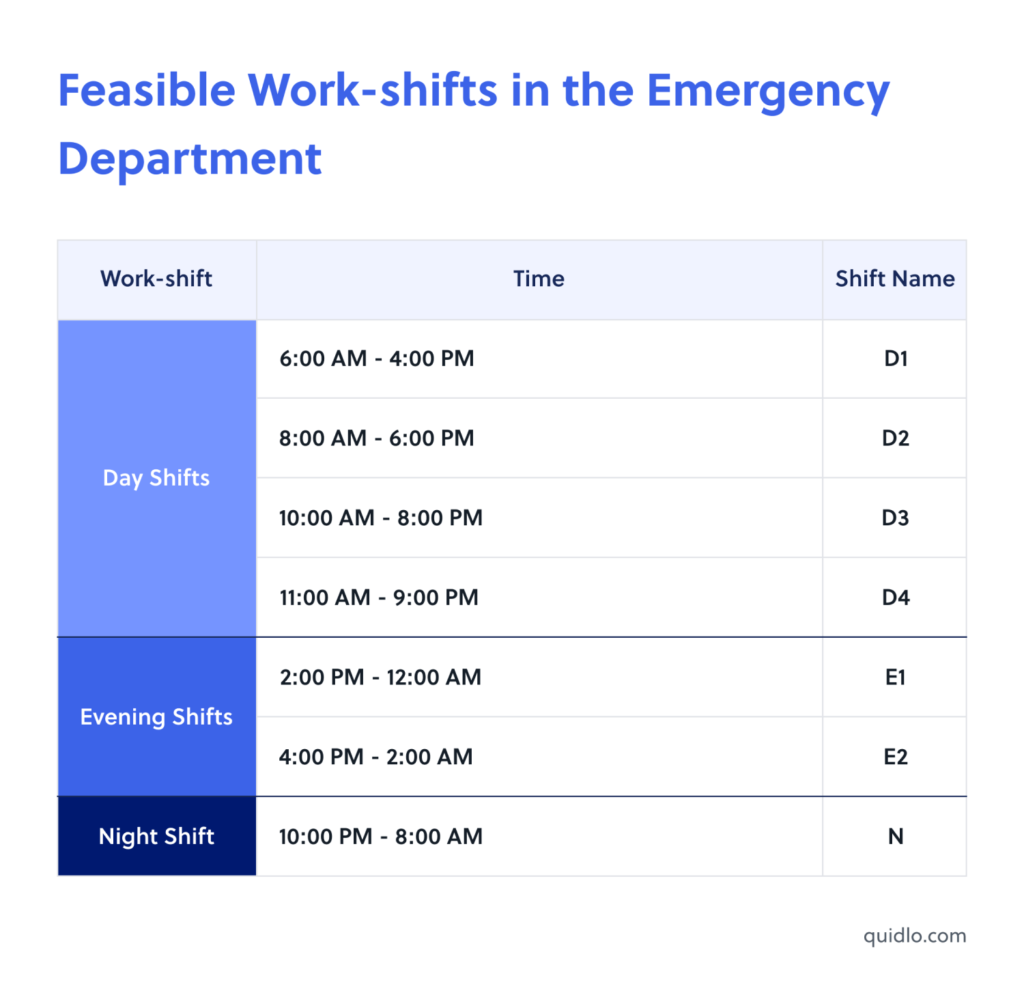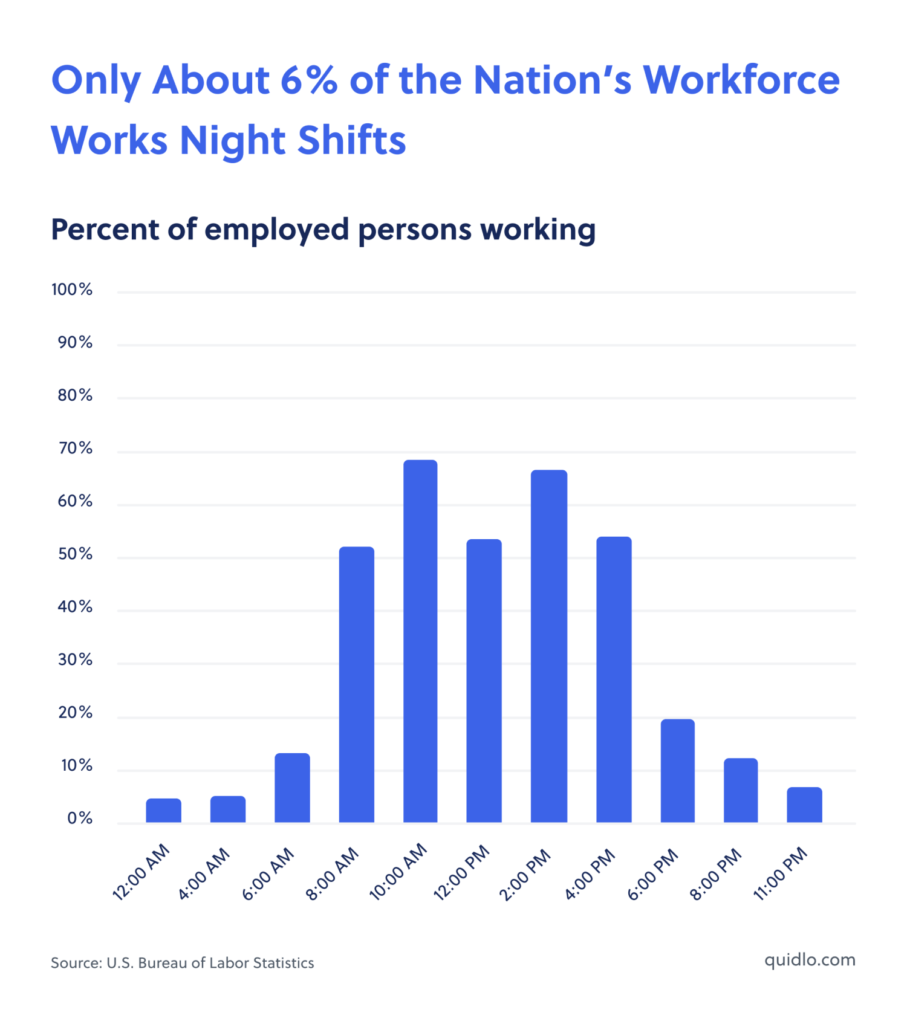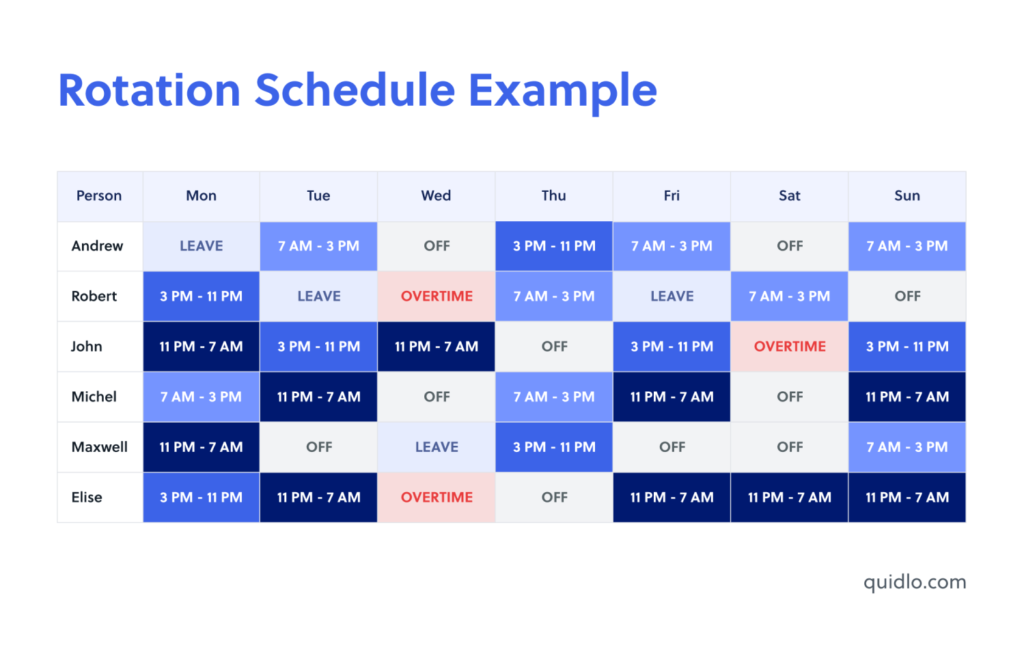When it comes to work schedules, there are different options to choose from depending on your workplace, industry, and preference. Some companies prefer the traditional 9-to-5 schedule, while others opt for split shifts, long shifts, or even rotating schedules.
But whether you’re currently working a shift job or are a manager considering introducing shift schedules, it’s important to understand the different types of shifts that are out there.
In this article, we’ll be discussing one particular type of shift: The third shift, also known as the graveyard shift. We’ll cover everything from the standard hours of the third shift to the reasons why people choose to work it and the benefits and drawbacks of the shift.
Let’s get started!
Table of Contents
What is Third Shift?
The third shift refers to a work schedule that typically occurs during the late hours of the night (the hours right before midnight) and early hours of the morning, which we discuss in the next section.
Since third shifts are during non-daylight hours, they are considered the most unique and challenging work schedules. So, if you’re thinking about working the third shift, it’s crucial to understand what you’re getting into and ensure it’s the right fit for you.
Typical Third Shift Hours
The typical third shift hours are usually between 11 pm and 8 am.
However, it’s important to note that the specific hours vary depending on the industry and the particular job.
For example, in a 24-hour retail store, a third shift may start at 9 pm and end at 6 am. On the other hand, a nurse’s third shift in a hospital may start at 10 pm and end at 8 am, as shown below.

Some of the shifts may also overlap and have employees from different shifts working at the same time, as in the schedule above.
Why is it Called Graveyard Shift?
The term graveyard shift is believed to have originated in the late 19th century when people used it to refer to the night shift at a factory or other industrial facility. Most people were asleep during this time, and the workplace and streets were empty, making it feel like a “graveyard.”
Eventually, the term “graveyard shift” began to be used more widely to refer to any type of overnight work, including factory or industrial jobs and jobs in transportation, security, and healthcare.
Why do People Work Third Shifts (Graveyard Shifts)?
There are a variety of reasons why people choose to work third shifts.
First, some industries require round-the-clock operations and, therefore, need workers to cover the overnight hours. For example, nurses, doctors, and other healthcare professionals in a hospital may work the third shift to provide care for patients around the clock.
Another reason some people prefer working this shift is that it often comes with premium pay. Employers tend to offer higher pay for overnight jobs since they are less preferred by most employees, as shown in the image below.

In some cases, people choose to work the night shift because it may offer more flexible working hours. For example, say someone is a full-time student during the day. Working the third shift allows them to attend school comfortably, and they can work at night.
Besides that, some people simply find it easier to focus and be productive during the night and, therefore, enjoy working the third shift.
Benefits of Third Shift
While several challenges are associated with working the third shift, it can also offer a unique set of advantages. Some of the key benefits of working the night shift include:
Higher pay: Employers may offer a higher pay rate for hours worked during the third shift as it tends to be less desirable for some employees.
More job opportunities: Some industries require round-the-clock operations and, therefore, need workers to cover the overnight hours. This can open up job opportunities that may not be available during other shifts.
Less crowded work environments: If you prefer a quieter environment, you may enjoy working the third shift as it’s often less busy than other shifts. This means you may also have more access to resources and equipment, allowing you to get your work done more efficiently.
Less traffic: One of the most apparent benefits of working the third shift is avoiding rush hour traffic. This can save you the time and stress of getting to and from work.
It’s key to note that the benefits of working the third shift are unique to each individual. Therefore, weigh the pros and cons of working the shift and consider your lifestyle, health, and overall well-being before making a decision.
Drawbacks of Third Shift
While there are some benefits to working overnight hours, it’s essential to be aware of the potential drawbacks. Here are some of the most common ones:
Disruption of circadian rhythm: The human body is naturally programmed to be awake during the day and asleep at night. Working the third shift can disrupt this natural rhythm and lead to various health issues such as insomnia, fatigue, and depression.
Poor social life: Since the third shift is not in sync with most people’s schedules, it can be challenging to maintain a social life and make plans with friends and family. This negatively impacts these personal relationships.
Increased risk of burnout: Due to the demanding nature of these shifts, especially for jobs in the healthcare industry, it can be easy to burn out and experience physical and emotional exhaustion.
Increased risk of accidents: Third shifts have been linked with a higher risk of accidents due to fatigue and decreased alertness.
Difficulty finding childcare: If you are a parent, it can be difficult to find childcare services during night hours compared to daytime hours.
Some people can make the third shift schedule work for them despite the downsides. But it’s key to consider how the shift may affect you as an individual before deciding to work it.
Industries with Common Third Shift Jobs
Several industries commonly use third shift or graveyard shifts for their operations, including:
The Healthcare industry
Hospitals, nursing homes, and other healthcare facilities often need round-the-clock staffing to cater to medical emergencies. This is why many healthcare workers, such as nurses and doctors, are required to work overnight shifts.
Manufacturing and production industry
Most facilities in this industry operate round the clock to keep up with production demands. This means that third shift positions are often available for assembly line workers, machine operators, and other production staff.
Transport industry
Transportation and logistics companies that transport and deliver goods also need employees to work overnight shifts. This includes truck drivers, warehouse workers, and logistics coordinators.
Hospitality industry
The hospitality and food business is the other industry that commonly has third shift jobs. For instance, hotels and airports have staff working overnight to ensure guests are served throughout.
The retail industry
This industry also has common third shift jobs since most retail stores are open 24/7. Hence, they need the staff to work overnight shifts to keep the store running, especially for stocking, cashier, security, and customer service positions.
Most of these industries use the third shift employees to ensure their operations run smoothly while meeting customers’ demands.
How to Make Third Shift Work for Your Team and Business
As a business owner or manager, introducing a third shift schedule can have its challenges. However, with the right approach and considerations, you can make the transition smooth for your team and business. Here are some best practices to keep in mind:
Provide training: Provide your team with the necessary training to handle the demands of working overnight. This can include training on safety procedures, time management, and handling the physical and mental demands of working overnight.
Communicate clearly: This includes changes to their schedules, pay, and responsibilities. Also, provide a point of contact for questions or concerns.
Be aware of health and safety effects: Third shift schedules can affect employees’ health and well-being. Be mindful of the potential impacts and take steps to mitigate them, like offering wellness programs or providing access to counseling services.
Be aware of the legal requirements: Pay attention to legal requirements for working overnight shifts, and make sure that your team complies with all relevant laws and regulations.
Consider incentives: Companies offer shift differential and other incentives to employees to ease the transition and make the third shift schedule more attractive. This can include offering shift differentials, bonuses, or other benefits.
Consider rotating shifts: Try to rotate shifts as much as possible to avoid permanent third shifts, as shown in the schedule template below. This can help to prevent burnout and fatigue.

Following these key practices and paying attention to the unique challenges of working overnight will enable you to help your team thrive on the third shift schedule.
Third Shift Frequently Asked Questions
Is Working Third Shift Hard?
Working the third shift can be challenging due to the disruption of natural sleep patterns and the potential for social isolation. However, if you take the right steps to prepare for the shift, you can work comfortably.
Is it Unhealthy to Work Third Shift?
Studies have shown that working the third shift can negatively affect third shift workers’ health, including an increased risk of certain cancers, cardiovascular diseases, and sleep disorders such as insomnia.
This is why employers are encouraged to provide resources and train their employees working the third shift to combat these issues.
How do You Survive Third Shift?
Working the third shift can be challenging, but there are steps you can take to make the transition easier. Strategies for coping with third shift work include developing a regular sleep schedule to help your body adjust to the schedule, staying active when awake, and staying connected with friends and family to ensure a better work-life balance.
How Many Night Shifts is Too Many?
The number of night shifts considered “too many” can vary for different shift workers. However, working too many night shifts can increase the risk of health problems and burnout.
Studies have found that working more than 3-4 consecutive night shifts can increase the risk of getting diseases like Cancer and other health conditions.
How Much Should I Pay a Third Shift Employee?
The pay rate for third shift employees may be slightly higher than the standard pay due to the potential challenges and inconvenience. However, discuss the rates with your HR department and a labor lawyer to ensure compliance with local and federal laws.







